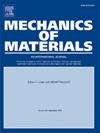基于注意力增强深度学习的随机多孔材料应力应变响应预测与反设计
IF 3.4
3区 材料科学
Q2 MATERIALS SCIENCE, MULTIDISCIPLINARY
引用次数: 0
摘要
微观结构和材料性能之间的相互映射是材料设计的基础。为了实现具有目标应力应变响应的随机多孔材料的逆向设计,本研究引入了一个潜在空间驱动的、注意力增强的深度学习框架。通过高斯随机场的水平切割生成了近2万种随机多孔材料,并通过有限元分析模拟了它们的弹塑性响应。为了减少计算成本,使用变分自编码器(VAE)将微观结构投影到潜在的低维表示空间中。在此基础上,基于时间一致性的内涵,将应力-应变响应预测任务重新表述为时间预测问题,并利用基于注意机制的序列变换模型解决时间预测问题。最后,开发了一个VAE2SeqT模型,将微观结构数据映射到基于序列的表示。此外,提出了一种自适应权微分增强损失函数来捕捉应力-应变曲线的时间依赖性。在逆向过程中,基于NSGA-III的多目标优化算法在潜在搜索域中寻找最接近目标的Pareto最优解,并将其映射回原始像素空间。结果表明,潜在空间驱动的深度学习框架在正向预测和逆向设计方面都表现良好,为不同领域复杂材料的目标设计提供了有希望的途径。本文章由计算机程序翻译,如有差异,请以英文原文为准。
Attention-enhanced deep learning for stress-strain response prediction and inverse design of random porous materials
The mutual mapping between microstructures and material properties is fundamental to material design. To enable the inverse design of random porous materials with targeted stress-strain responses, this study introduces a latent space-driven, attention-enhanced deep learning framework. Nearly 20,000 random porous materials were generated through level-cut of Gaussian random fields, and their elastoplastic responses were simulated via finite element analysis. To reduce computational cost, the microstructure was projected into latent low-dimensional representational space using a variational autoencoder (VAE). Furthermore, based on the connotation of time consistency, the task of predicting stress-strain responses was reformulated as a temporal prediction problem, which was then addressed using a sequence transformer model based on the attention mechanism. Finally, a VAE2SeqT model was developed to map microstructure data to sequence-based representations. Additionally, an adaptive weight differential-enhanced loss function was proposed to capture the time-dependent nature of stress-strain curves. In the reverse process, a multi-objective optimization algorithm based on NSGA-III explores the Pareto optimal solutions closest to the target in the latent search domain, which are then mapped back to the original pixel space. The results demonstrate that latent space-driven deep learning frameworks perform well in both forward prediction and inverse design, offering promising pathways for the targeted design of complex materials in different fields.
求助全文
通过发布文献求助,成功后即可免费获取论文全文。
去求助
来源期刊

Mechanics of Materials
工程技术-材料科学:综合
CiteScore
7.60
自引率
5.10%
发文量
243
审稿时长
46 days
期刊介绍:
Mechanics of Materials is a forum for original scientific research on the flow, fracture, and general constitutive behavior of geophysical, geotechnical and technological materials, with balanced coverage of advanced technological and natural materials, with balanced coverage of theoretical, experimental, and field investigations. Of special concern are macroscopic predictions based on microscopic models, identification of microscopic structures from limited overall macroscopic data, experimental and field results that lead to fundamental understanding of the behavior of materials, and coordinated experimental and analytical investigations that culminate in theories with predictive quality.
 求助内容:
求助内容: 应助结果提醒方式:
应助结果提醒方式:


